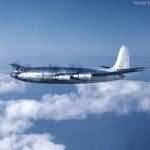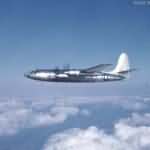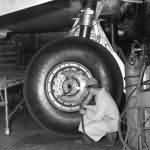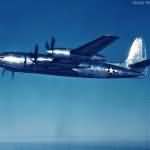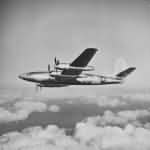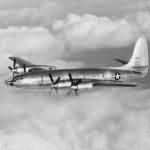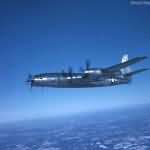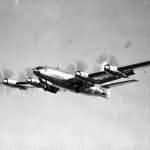XR-12
XF-12
XF-12
Rainbow in flight
Rainbow in flight
XF-12
XF-12 44-91002
XF-12
main landing gear
XF-12
XF-12 44-91002 on the ground
XF-12
XF-12
XF-12
XF-12
XF-12
XF-12
XF-12
XF-12
The initial proposal for the aircraft was made in late 1943 by the Air Technical Service Command of the USAAF at Wright Field. The reconnaissance aircraft proposal included speed 400 mph (644 km/h), ceiling 40000 ft (12,192 m), and range 4000 nautical miles (7408 km) requirements. The main task of the new aircraft was to make high-speed overflights over the islands of the Japanese mainland and key enemy targets. During World War II, due to the requirements for increased range in the Pacific theater, reconnaissance flights were made by unsuitable aircraft – fighters and bombers – and, as a result, the need for a specialized photographic reconnaissance aircraft was urgently raised. The new aircraft had to have high speed, range and altitude in order to successfully accomplish its missions.
In August 1943 Colonel Eliot Roosevelt recommended the acquisition of specialized photographic reconnaissance aircraft with high flying characteristics. According to Roosevelt, these machines were to collect information and decode photographs of targets before attacking them, followed by additional overflights to provide analysis of the strikes and make decisions about destroying targets easier. Also, the characteristics of this type of aircraft should give unit commanders the ability to make critical strategic decisions and determine targets for subsequent raids. Republic Aviation’s XF-12 was an attempt to meet these requirements. Its main competitor at the time was the Hughes XF-11. Both aircraft were introduced at about the same time and both were powered by the new Pratt & Whitney R-4360 engines. The XF-12 made its first flight on February 4, 1946. During a subsequent period of flight testing and refinement, Republic’s aircraft demonstrated the ability to fly at 45,000 feet (14,000 m) and at 470 mph (740 km/h) with a range of 4,500 miles (7,200 km), which exceeded the requirements of the mission for which it was designed. Neither the XF-11 nor the XF-12 were adopted by the U.S. Army Air Forces (only two aircraft each were purchased) because the need for such machines disappeared after World War II.
When the XF-12 was modified by installing “all-weather” equipment and equipping it with new engines capable of short-range boost, it suddenly gained great importance in the eyes of the U.S. Air Force and State Department. As a powerful reconnaissance weapon, the XF-12 was capable of ultra-long-range flights at high altitudes and speeds and of taking photographs of enemy targets, both by day and in limited visibility. In theory, this “flying darkroom”, operating from northern bases (Alaska and Canada), was capable of mapping vast areas of Arctic territory and conducting reconnaissance flights while remaining almost invulnerable.
The most successful part of XF-12 flight operations was Operation Bird’s Eye. This mission was conceived to demonstrate the full capabilities of the newly redesignated XF-12’s photographic equipment. On September 1, 1948, the second XF-12 prototype took off from the USAF Munrock Air Force Center, California, and, heading westward toward the Pacific, began to gain altitude. Upon reaching a cruising altitude of 4,000 feet (12,192 m), XF-12 turned eastward and began photographing its entire flight path over the United States. The crew filmed a continuous strip of film 325 feet (99 m) long. The film consisted of 390 individual photographs (10 inches [254 mm] per frame) and covered a field of view 490 miles (788 km) wide. The aircraft landed at Mitchell Field, Garden City (Long Island, New York City), completing a flight of 6 hours 55 minutes. The average flight speed was 361 mph (581 km/h), thus 1 min 4 sec per picture. Pictures of this spectacular flight were featured in the November 29, 1948 issue of Life magazine and the resulting film was exhibited in New York City at the 1948 U.S. Air Force Association Convention.
However, at the time of this record-breaking flight the U.S. Air Force canceled the XF-12 program. The main reason for the closure was the availability of the Boeing B-29 Superfortress and Boeing B-50 Superfortress bombers, capable of performing long-range photographic reconnaissance missions, until the adoption of the higher-performance Boeing RB-47 Stratojet. For the U.S. Air Force, the B-29 and B-50 were less expensive “off the shelf” versions.
However, Republic did not want to give up and planned to build an airliner on the basis of the XF-12, assigning to this variant the intercompany designation RC-2. This version was to be a “stretched” version of the XF-12, increased in length from 93 feet 9 inches (28.56 m) to 98 feet 9 inches (30.1 m). This fuselage “insertion” was to be added in front of the wing. Changes were also to be made to the fuselage nose: instead of a plexiglass nose assembly, an all-metal nose with a split windshield was to come. The fuel tank capacity was to increase and the power plant was to consist of more powerful and lower-altitude Pratt & Whitney R-4360-59 engines, which replaced the Pratt & Whitney R-4360-31 (U.S. Air Force version). Instead of two turbochargers on the U.S. Air Force model, each engine of the future airliner was to have only one turbocharger. The aircraft, designed to carry 46 passengers and 7 crew members, was to be richly equipped. The airplane had to be fully pressurized in the passenger cabin as at sea level, have air conditioning, an electric galley providing hot meals for the passengers, and a lounge for in-flight relaxation. The passenger plane was to be capable of flying in all weathers at 4,000 feet (12,192 m) with a cruising speed of 435 mph (700 km/h). However, this version of the XF-12 was never built. In the absence of an order from the U.S. Air Force to offset development and tooling costs, the cost of building civilian aircraft would have skyrocketed. As a result, two companies (American Airlines and Pan American World Airways [Pan-Am]) that had placed pre-orders for delivery cancelled their bids because of the additional unit costs. Economically, the RC-2 was not feasible due to other projects available at the time, such as the Lockheed Constellation and Douglas DC-6. Lockheed and Douglas machines could carry more passengers at a lower cost per mile of flight. In addition, after World War II ended, a large number of Douglas C-54 Skymaster military transport planes became unnecessary. These former transport planes were easy to adapt for passenger flights, and besides, the cost of converting a transport plane to an airliner was only a fraction of buying a new plane. In the absence of additional orders, Republic cancelled all further plans to build not only the XF-12, but also the RC-2, settling on only two of the original prototypes.
On November 7, 1948, while returning to Eglin Air Force Base, Florida, the second prototype (44-91003) crashed at 1:00 p.m. The No.2 engine exploded as the aircraft was returning from a test flight to determine its suitability for photographic reconnaissance missions. Due to severe buffeting, the pilot was unable to maintain control of the machine and ordered the crew to abandon the aircraft. Five crew members, including pilot Lynn Hendrix, parachuted safely and were recovered from the water by rescue boats and helicopters from Eglin Air Force Base. The plane crashed two miles south of the air base into Choctawhatchee Bay; Sgt. Sgt. Vernon B. Palmer and M/Sgt. Victor C. Riberdy died. The first prototype, which returned to service in 1948, continued its flight tests and refinement phase. After the U.S. Air Force refused to order any additional aircraft and due to the loss of the second prototype, the flight test period was nearing completion. In June 1952, the first prototype (44-91002) was scrapped (the machine had flown an additional 117 hours in 1949-52) and ended its life as a target at Aberdeen Proving Ground, Maryland.
If the XF-12 Rainbow had appeared in 1944, it would almost certainly have been ordered in large numbers, as would its civilian version, which would certainly have resulted in a significant change in the postwar airline market structure. However, despite its high performance and sleek lines, the XF-12 disappeared into oblivion. Rainbow was the ultimate achievement among multi-engine piston airplanes. Its high speed, almost perfectly streamlined shape and carefully tapered engines made the XF-12 a design classic that unfortunately is often underestimated and not very well known. The XF-12 was the fastest four-engine piston airplane of its time, the only one that could reach over 450 mph (724 km/h) in horizontal flight. The closest the XF-12 Rainbow came was the Wasp Major-powered Boeing RB-50B reconnaissance aircraft (converted from bombers), which at 25,000 feet (7,620 m) could reach only 385 mph (620 km/h).


